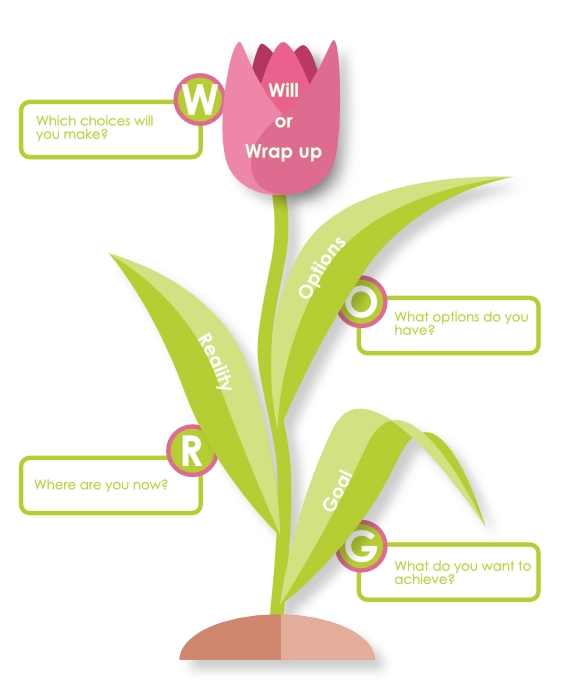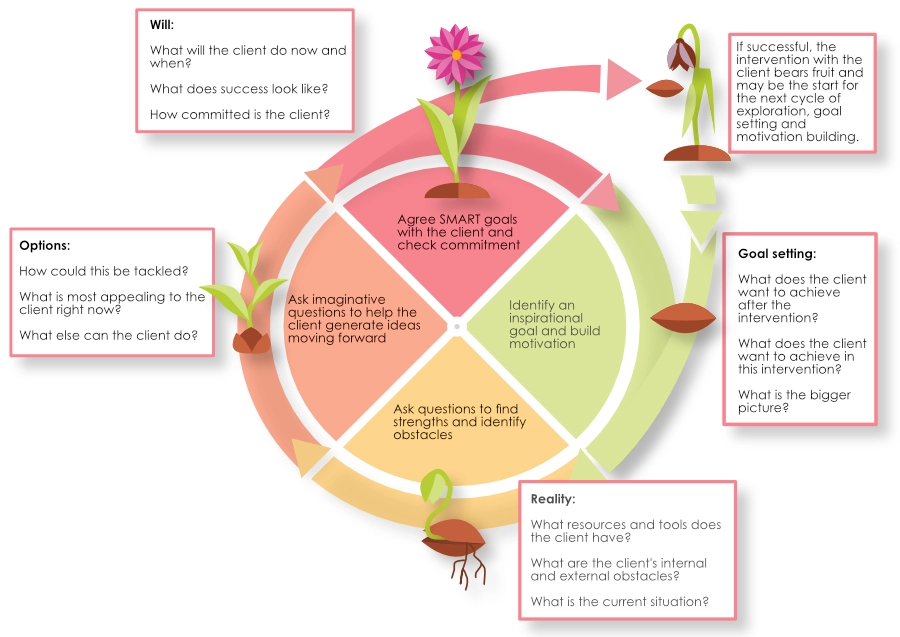The GROW model
Sir John Whitmore (1992)
Table of Content
Definition
The GROW model is a tool for goal setting that’s, at a distance, reminiscent of other models such as DOTS. Just like DOTS, GROW is an acronym that stands for:
- G – Goal – what does the client want to achieve?
- R – Reality – where is the client in relation to their goal?
- O – Options – extensive exploration of all the options in a client centred way so the client takes ownership of these options.
- W – Will or Wrap up, or Way forward (there is some discussion about which is correct and which of these isn’t!) – how can the client commit to the action they agreed on and what help do they have to achieve them?
Representation of the different facets of the GROW Model.

This is however, a linear and static representation of the GROW model. As we will see below, it isn’t really used like that. Or in other words, it’s not a linear model but a circular process model that can feed back on itself.
Genetics
GROW was influenced by the Inner game method (W. Timothy Gallwey, 1974) which preceded it by a number of years.
GROW has been influential in the coaching world for a long time, less so in career guidance circles, which, I have a feeling, only relatively recently got closer to coaching. In fact, this now seems to be a trend, and in my view quite rightly so for a number of diverse reasons.
The GROW model has been the basis, consciously or not, of many other models later on. One example is the WOOP model. As far as acronyms go, you can’t make it up, can you? But someone clearly has!
It’s also not difficult to see some similarities with even the Stages of Change model and as I mentioned before, the DOTS model to some extent.
Context
For most of us who have been trained and educated in career guidance, a lot of this will sound familiar.
- In goal we can see the contracting stage
- Establishing the Foundations stage in the SDS model
- Seeking engagement from the client – is the client ready and willing?
- What does the client want to talk about and what can and can’t be done in today’s intervention.
- What will the objective be or what does the client want to aim for?
- How are we going to achieve this? – including confidentiality, how to work together, managing expectations etc…
- Reality explored where the client is right now.
- The Establishing Needs stage in the SDS model
- Knowledge about ‘Self’.
- Exploring the context and the story.
- Are there any obstacles?
- Gaining insight into the client’s needs.
- Options
- Second part of the Establishing Needs stage in the SDS model
- Knowledge about ‘Opportunities’
- Similar to the Opportunities stage in DOTS and other models.
- Where are the opportunities and ‘what can be done?’
- Client centred work to enhance the client’s ownership.
- Managing the selection process together with the client as only decision maker.
- Will/Wrap up/Way forward
- Addressing Needs stage in the SDS model
- Taking stock of what has been achieved.
- The Transitions and Decisions stage in DOTS.
So you see from my interpretation that a lot of the GROW model is familiar but it doesn’t quite fit other models like a glove. In my view, a lot of other models take the GROW model and build detail into it. Just like the DOTS model, it’s a model for a ‘broad strokes’ overview rather than detailed work. It provides a broad structure. For experienced career professionals this may be all that is needed, but for those who are trying to get to grips with career guidance and career coaching, more detail may be needed.
Some guidance organisations may also use the GROW model as a basis or foundation for their own approach or their own interpretation of career guidance and coaching.
Using GROW in practice

This is representation of the GROW model as used in practice, as a process with individual steps to go through. You can probably notice that it can be interpreted in a similar way to some other models, though the content is a bit different. The first thing that springs to mind when looking at the model in this way is DOTS. In one interpretation of DOTS it’s seen in the same way, as a series of steps to go through (SODiT). On the other hand, Law himself argued that DOTS doesn’t need to be approached as a process that way and that each of the four elements of DOTS can be approached individually or in an order relevant to the client’s needs (Julia Yates, Bill Law, 2013, 21:27). Apart from DOTS, the GROW model is also reminiscent of all the other ‘process’ or ‘flow’ models used in interventions, as mentioned above. Even to some extent Prochaska and DiClemente’s Stages of change model, but that requires some brain gymnastics.






